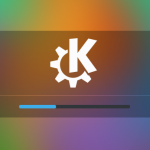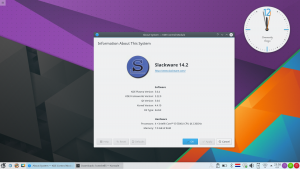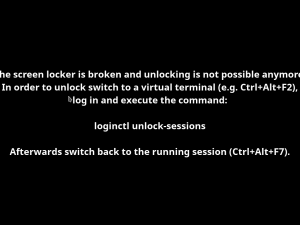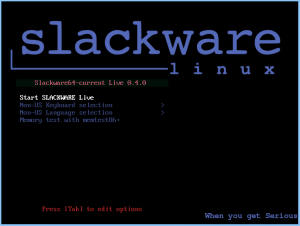 While everyone is waiting for the 14.2 release of our beloved Slackware Linux distribution, those pesky developers keep releasing their own software. So this was the week where KDE Frameworks, Plasma and Applications all had newer versions than I have in my repository. Guess what – I have prepared a new set of Plasma5 packages for the month of May so that I am ready for a new Live ISO… next Slackware release or not.
While everyone is waiting for the 14.2 release of our beloved Slackware Linux distribution, those pesky developers keep releasing their own software. So this was the week where KDE Frameworks, Plasma and Applications all had newer versions than I have in my repository. Guess what – I have prepared a new set of Plasma5 packages for the month of May so that I am ready for a new Live ISO… next Slackware release or not.
KDE 5_16.05 is my May release of the combined KDE Frameworks 5.22.0, Plasma 5.6.4 and Applications 16.04.1.
What’s new in KDE 5_16.05?
- Frameworks 5.22.0 is an enhancement release with one new framework which was moved here from Plasma: kwayland (we do not yet use this in Slackware). See https://www.kde.org/announcements/kde-frameworks-5.22.0.php
- Plasma 5.6.4 is another bugfix release of the 5.6 series. See https://www.kde.org/announcements/plasma-5.6.4.php .
- Applications 16.04.1 is also a maintenance release. See https://www.kde.org/announcements/announce-applications-16.04.1.php .
- I have fixed the ‘sddm-qt5’ package and now SDDM starts (almost) instantaneously again when entering runlevel 4. Some months ago, the “sddm” user account which is used by SDDM was added to Slackware by Patrick, but it was configured with homedirectory which is not useful (“/var/empty” instead of what my package uses, “/var/lib/sddm”). The “sddm” user account writes its status files to its homedirectory. The ‘sddm-qt5’ package’s post-installation script (doinst.sh) will now modify the homedirectory of the “sddm” user if it already exists on the system. Tip: after upgrading, please check the “sddm” account (using “getent passwd sddm” command) and fix the homedirectory manually if for whatever reason, the ‘doinst.sh’ script was not successful in its modification.
All in all, a fairly trivial upgrade if you already have my Plasma 5 packages installed. See below for install/upgrade instructions. If you want to give it a trial run, I hope to have a Live ISO available at http://bear.alienbase.nl/mirrors/slackware-live/ soon. Check the timestamp of the “slackware64-live-plasma5-current.iso” ISO.
Installing or upgrading Frameworks 5, Plasma 5 and Applications
You can skip the remainder of the article if you already have my Plasma 5 installed and are familiar with the upgrade process. Otherwise, stay with me and read the rest.
As always, the accompanying README file contains full installation & upgrade instructions. Note that the packages are available in several subdirectories below “kde”, instead of directly in “kde”. This makes it easier for me to do partial updates of packages. The subdirectories are “kde4”, “kde4-extragear”, “frameworks”, “kdepim”, “plasma”, “plasma-extra”, “applications”, “applications-extra” and “telepathy”.
Upgrading to this KDE 5 is not difficult, especially if you already are running KDE 5_16.04. You will have to remove old KDE 4 packages manually. If you do not have KDE 4 installed at all, you will have to install some of Slackware’s own KDE 4 packages manually.
What I usually do is: download all the ‘ktown’ packages for the new release to a local disk. Then run “upgrade –install-new” on all these packages. Then I check the status of my Slackware-current, upgrading the stock packages where needed. The slackpkg tool is invaluable during this process of syncing the package installation status to the releases.
Note:
If you are using slackpkg+, have already moved to KDE 5_16.04 and are adventurous, you can try upgrading using the following set of commands. This should “mostly” work but you still need to check the package lists displayed by slackpkg to verify that you are upgrading all the right packages. Feel free to send me improved instructions if needed. In below example I am assuming that you tagged my KDE 5 repository with the name “ktown_testing” in the configuration file “/etc/slackpkg/slackpkgplus.conf“):
# slackpkg update
# slackpkg install ktown_testing (to get the newly added packages from my repo)
# slackpkg install-new (to get the new official Slackware packages that were part of my deps previously)
# slackpkg upgrade ktown_testing (upgrade all existing packages to their latest versions)
# removepkg xembed-sni-proxy ktux amor kde-base-artwork kde-wallpapers kdeartwork (they don’t exist in the repo anymore)
# slackpkg upgrade-all (upgrade the remaining dependencies that were part of my repo previously)And doublecheck that you have not inadvertently blacklisted my packages in “/etc/slackpkg/blacklist“! Check for the existence of a line in that blacklist file that looks like “[0-9]+alien” and remove it if you find it!
Recommended reading material
There have been several posts now about KDE 5 for Slackware-current. All of them contain useful information, tips and gotchas that I do not want to repeat here, but if you want to read them, here they are: http://alien.slackbook.org/blog/tag/kde5/
A note on Frameworks
The KDE Frameworks are extensions on top of Qt 5.x and their usability is not limited to the KDE Software Collection. There are other projects such as LXQT which rely (in part) on the KDE Frameworks, and if you are looking for a proper Frameworks repository which is compatible with Slackware package managers such as slackpkg+, then you can use these URL’s to assure yourself of the latest Frameworks packages for Slackware-current (indeed, this is a sub-tree of my KDE 5 “testing” repository):
- http://taper.alienbase.nl/mirrors/alien-kde/current/testing/x86/kde/frameworks/
- http://taper.alienbase.nl/mirrors/alien-kde/current/testing/x86_64/kde/frameworks/
Where to get the new packages for Plasma 5
Download locations are listed below (you will find the sources in ./source/5/ and packages in /current/5/ subdirectories). If you are interested in the development of KDE 5 for Slackware, you can peek at my git repository too.
Using a mirror is preferred because you get more bandwidth from a mirror and it’s friendlier to the owners of the master server!
- http://alien.slackbook.org/ktown/ (the master repository, will be slow), rsync URI: rsync://alien.slackbook.org/alien/ktown/
- http://bear.alienbase.nl/mirrors/alien-kde/ (my own new fast mirror), rsync URI is rsync://bear.alienbase.nl/mirrors/alien-kde/.
- http://repo.ukdw.ac.id/alien-kde/ (willysr’s Indonesian mirror), rsync URI: rsync://repo.ukdw.ac.id/alien-kde/
- http://ftp.lip6.fr/pub/linux/distributions/slackware/people/alien-kde/ French fast mirror thanks to Tonus.
- http://slackware.uk/people/alien-kde/ (fast UK based mirror, run by Darren Austin, rsync URI: rsync://slackware.uk/people/alien-kde/ )
Have fun! Eric




Recent comments